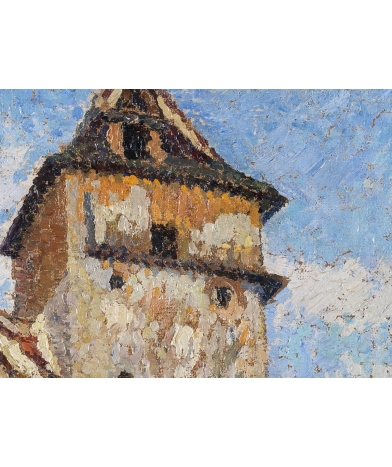Henri Martin (1860 - 1943) - Village médiéval de Saint Cirq Lapopie
Oil on canvas signed lower left
Dimensions : H. 90 x L. 115 cm (with frame: H. 110 x L. 134 cm)
Henri Martin, born in Toulouse in 1860, is one of the leaders of French neo-impressionism. He gave his name to the famous avenue Parisienne. A prolific artist, he left hundreds of works exhibited in the most important museums. In Cahors, the Henri Martin Museum will reopen its doors on May 6, 2022 and will once again pay tribute to the work of an artist whose official successes, won during his lifetime, were for a time forgotten.
After being briefly seduced by symbolism, Henri Martin adopted a pointillist technique close to that of Signac and Pissarro. However, his technique quickly moved away from academic models, in favor of an original divisionism that was more spontaneous than theorized: short, separate, parallel strokes build up the forms and light in an idealized chromaticism that is conducive to dreams. Melancholy and mystery add their particular tonality to the warm softness of his colors. Henri Martin remains the bard of a world pacified by painting, a world whose beauty is often similar to that of the Languedoc region, which he praises with simplicity.
In 1935, the City of Paris dedicated the second floor of the Petit Palais to Henri Martin. The retrospective brings together works from public and private collections and pays a remarkable tribute to an artist who has maintained a true modesty despite the honors and numerous awards that have marked his career. Henri Martin left many paintings in the Bordeaux Museum of Fine Arts, where a room was dedicated to him, but also in Cahors, where he had already decorated the prefecture and the town hall.
OUR PAINTING represents the "Medieval Village of Saint Cirq Lapopie". Perched above the river Lot, this village where Henri Martin and André Breton lived, seems to be straight out of the Middle Ages. Classified as a historical monument, Saint Cirq Lapopie was elected most beautiful village in France.
In addition to the rarity of this subject, it is a large format. Henri Martin used the slope of the alley to build his composition diagonally. The intense blue of the sky gives an openness in an essentially closed village representation. This painting is on its original canvas and is in absolutely perfect condition.






